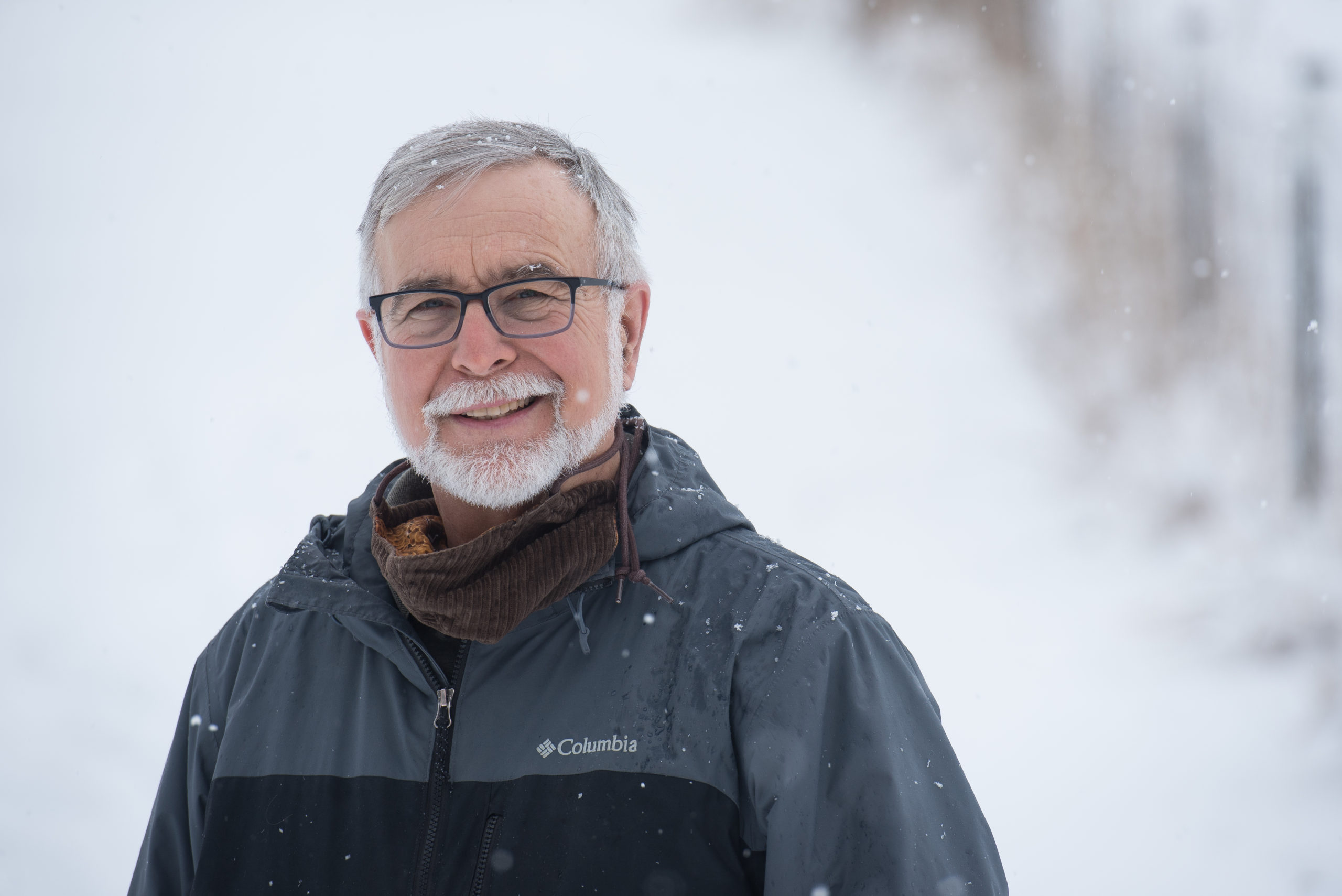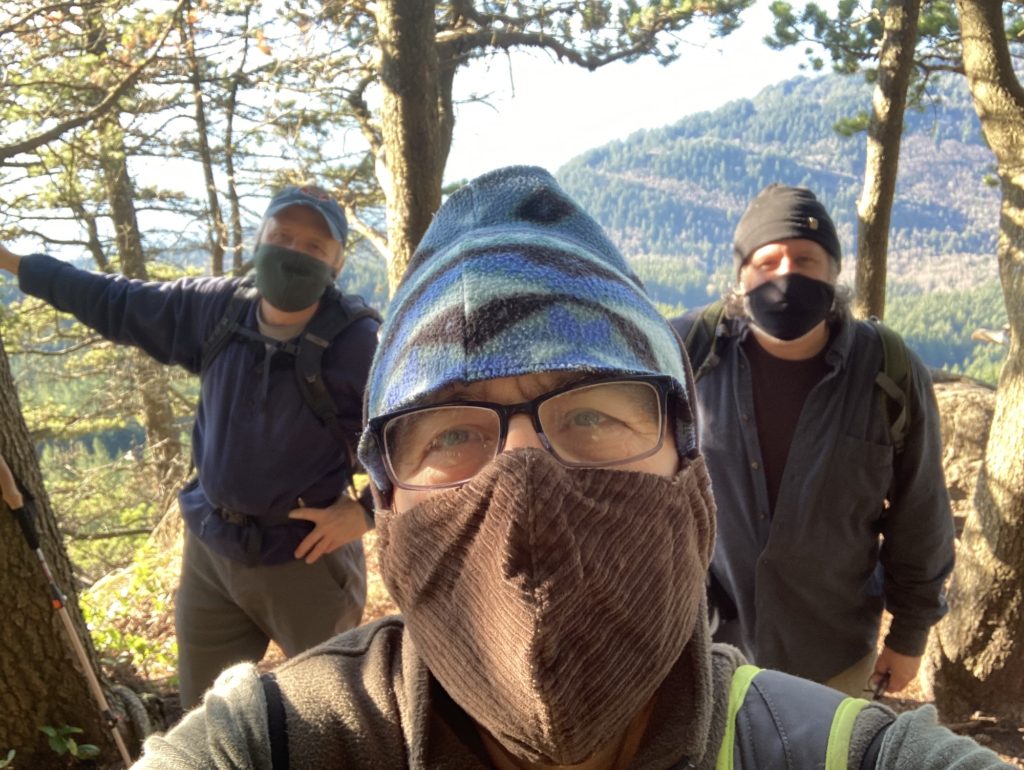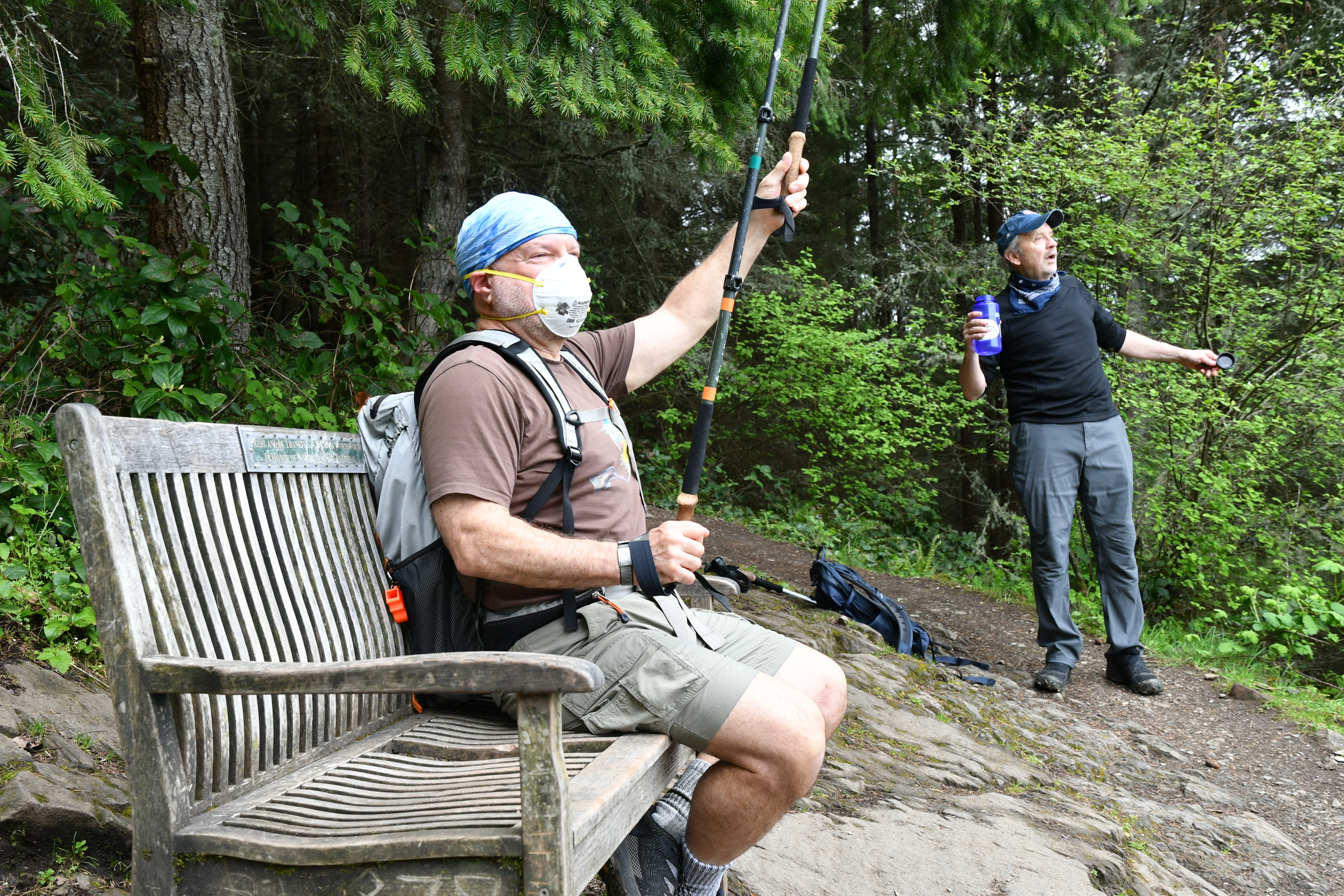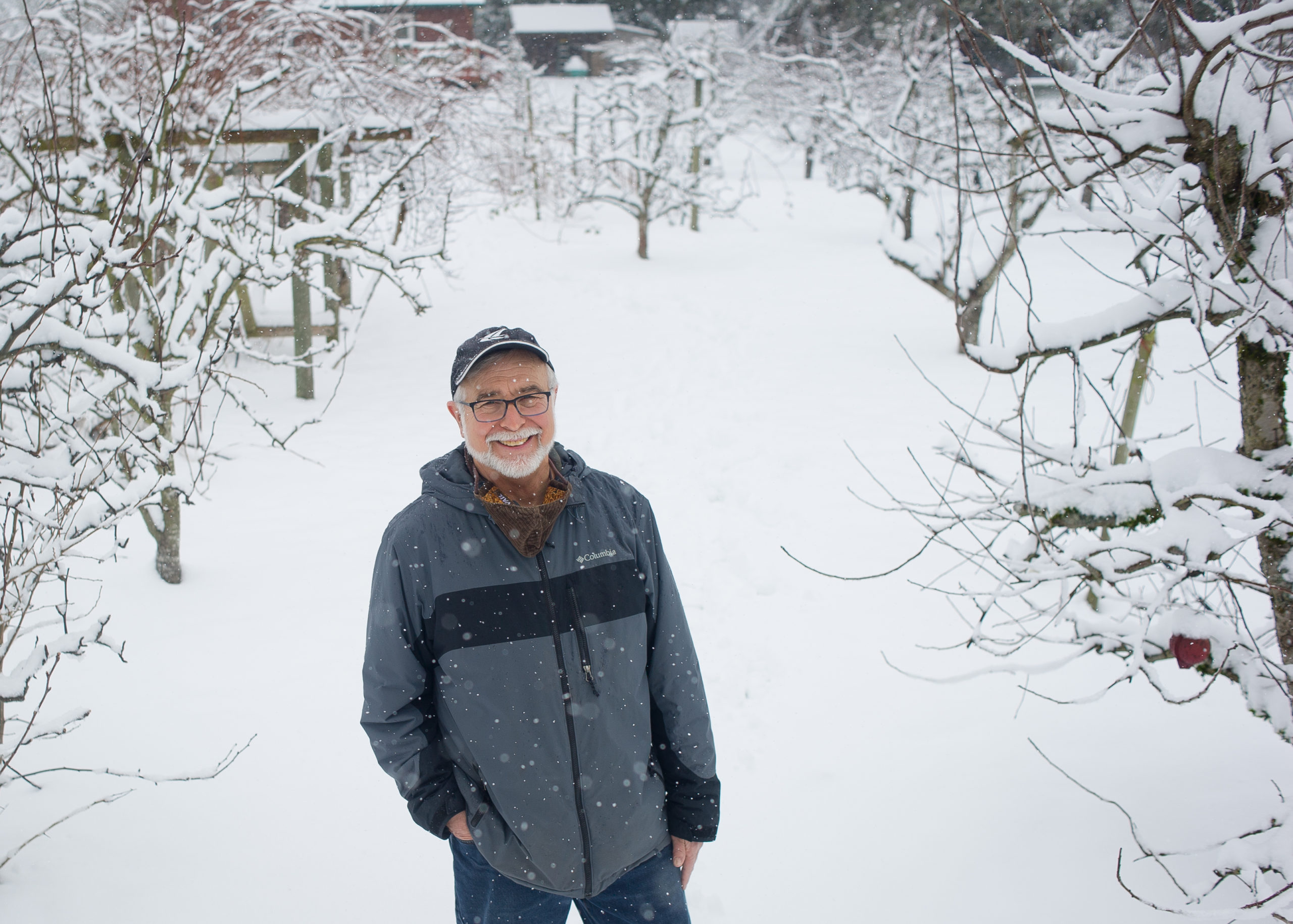Scott, Snow and Serendipity

How Professor Scott Terrell has taught photojournalism remotely.
Story by Jaya Flanary // Photos by Oliver Hamlin
I see a man hold his phone over his head to photograph one of the construction sites on campus. Assuming it’s Professor Scott Terrell, I head his way. It’s freezing, and feels like it’ll snow. Scott is wearing a funny-looking black fleece hat and a fabric mask with apples on it.

Conversations during the pandemic always start the same: playing catch-up with people you haven’t seen in far too long. I ask Scott what he’s been up to since Western Washington University switched to online classes in March of last year.
The first thing he thinks of is hiking. Scott, along with friends John Harris and Joe Gosen, two other journalism professors, regularly hiked through the Chuckanuts of Bellingham, Washington.
“It was just kind of like therapy,” Scott says. “We’re living in a place like this, so, why not … take advantage of it and be thankful for what we have?”
Back at home, in Bow, Washington, Scott’s daily life is relaxed. He walks his dog and works in his apple orchard, reminding me of the days when he brought loads of apples to class and harassed us to take as many as we wanted before we walked out the door.
“That’s one of the things I really missed in fall,” Scott says. “I taught photo-j in the fall, and I just missed bringing those apples in to the students because it was just a blast doing it.”
Without in-person classes to feed his students, Scott donates “hundreds of pounds” to the leaders of Skagit County.
At home, Scott lives with his wife, Karen Terrell, and their pets: Samantha, a Lab-Dane mix, and three cats, Clara, Sparky and Olive. In September, his son and son’s girlfriend moved in while they prepared to open their new business in downtown’s Granary Building called SconeGrown, a plant-based bakery.
Despite his full house, Scott finds time to work from home in the office he shares with his wife. He calls the office “cas” — as in casual. He upgraded his 2011 Macbook to an iMac during the pandemic to keep up with the advancement of online teaching.

“You’re Zooming, so you got to make sure your background is semi-cool. I think putting the landscapes behind is kind of distracting,” Scott says. “If the kids got to get on, they might as well just see me in the raw.”
I tell Scott I’ve noticed how many professors have crowded bookshelves behind them on camera. “Mine doesn’t look too scholarly,” he says, laughing. “It looks a little more disheveled, but, you know, that’s alright.”
Scott’s attitude reminds me of a student in a 67-year-old body.
Switching over to online-teaching last spring was a challenge for Scott, a Boomer, because he wasn’t Canvas-savvy. “I used Canvas kind of like a novice uses Photoshop. You learn how to crop a photo and you’re good to go,” Scott says.
As an adjunct professor, Scott teaches part-time, and was planning on only teaching J305, Photojournalism, last spring. However, he “took one for the team” by taking on J207, Newswriting, as well.
He dug deeper into Canvas, learned how to record lectures and planned the two classes as mostly asynchronous, only checking in once a week on Zoom.
“That was probably one of the most insane times of my life because I was just working morning to night trying to get all that stuff together,” Scott says. “I’m not Mr. Technology when it comes to all the modern interface stuff.”
Scott taught students the basics of using manual mode on a digital single-lens reflex camera. However, because all DSLR camera menus are different based on the brand, students were responsible for navigating their cameras at home. It worked well, and he even “took a page out of Joe’s playbook” by introducing some skills-based assignments to learn camera settings.
He also got stricter with caption writing. “Some of the standards that we normally adhere to in photo-j, we’re not going to be able to meet those [during COVID-19],” he says. “But that doesn’t mean you can’t write well.”

Feeling bad for students — who were anxious about moving, the pandemic and/or distractions at home — Scott let up on course requirements and deadlines. He even lightened restrictions on photographing roommates and family because everyone was quarantined.
Most of all, Scott emphasized the importance of social distancing and taking all safety precautions necessary while taking pictures. “You can’t require somebody to do something that’s deemed illegal,” Scott says.
The icebreaker assignment is one Scott assigns early in the quarter to get students comfortable approaching strangers. I remember being stressed about the icebreaker, because I felt uncomfortable taking pictures of strangers and approaching them after for their information.
When I took Scott’s class, in fall of 2018, I took my camera everywhere I went, hoping to capture raw emotion in the people around me. I photographed small business owners downtown Bellingham, locals picking pumpkins at the pumpkin patch and even kids jumping at the Trampoline Zone. Back when everything was open and we could see each others’ faces…
Approaching strangers is difficult, but approaching strangers during a pandemic is even more so. For the Photojournalism final, which is a photo story complete with captions, students were met with the challenge of finding and capturing a story during the lockdown.
One of Scott’s fall quarter students photographed a window washer through the windows of a downtown high-rise in Seattle, Washington. Another student photographed an 82-year-old owner of a work out gym in West Seattle.
“A lot of kids really persevered, and went out there and did what they could,” Scott says. “We have to show examples of where journalism is still being done, even during Covid.”
Scott used Peter Turnley’s photo series “A New York–Paris Visual Diary: The Human Face of COVID-19” as an example for his students to see how photojournalists are documenting the unprecedented times we are living in.
I begin to think about how 2020 was an extraordinary year for photojournalism in our country. There were beautiful, transformative photographs published of Americans facing the pandemic to Americans protesting for civil rights. But 2020 also developed discourse regarding photojournalism ethics, and many people disapproved of journalists publishing photos of protesters to protect their identities and safety from police.
A Visual Journalism major and writer for Klipsun magazine this quarter, Oliver Hamlin, who also happened to take the photos of Scott for this story, wrote about how the ethics of photojournalism should change.
I use Oliver’s thoughts as a baseline to ask Scott — an old-school photographer and professor — what he thought about the push-back against traditional photojournalism ethics.
Essentially, he supports the basic right to privacy: if an individual is in their living room, they’re not subject to being photographed. If they’re protesting in the streets, however, they are.
“A lot of journalists were taken aback when protesters got mad at them for taking their pictures,” Scott says. “If you are out protesting, you’re exercising your constitutional right to do that, and by golly, you’re out in public.”
He talks about the Seattle Police Department’s subpoena for raw footage from The Seattle Times and other media outlets in July of last year. Everything from Peggy Watt’s J350 class, Mass Media Law, swirls around in my head. The First Amendment. Freedom of the press. The Washington state shield law.
My journalism degree awaits me — I only have one quarter left.
During our discussion, we see one of my Klipsun story editors, Mazey Servin-Obert. She has a camera in her hands and a camera bag slung over her shoulder.
“Are you a photojournalist?” Scott asks loudly.
We find out that as we’ve been talking, Mazey has been taking photos of us from afar for her photojournalism class. Her professor is Joe Gosen, my adviser for the Alumni Newsletter. Small, small world of WWU journalism.

It starts to snow, and I realize how much I miss seeing campus change with the seasons.
“You bring your notebook?” Scott’s grandfather-like tone rings through his mask and I feel the same embarrassment I feel when my grandpa asks me what grade I’m in now.
Mazey holds up her phone instead of a notebook. “That’s what the cool kids are doing nowadays,” I remind Scott. We agree to do a walk-and-talk, The West Wing style, as Mazey photographs us for the very class Scott teaches.
We keep talking ethics, and agree that it’s always best to approach a subject and ask for their name. “I always liked to have IDs when running a photograph,” Scott says. “It’s your right as a journalist to document what’s going on. And it’s not just your right, it’s your job.”
Mazey gets our information for her assignment: our names, ages, pronouns and contact information. “That was just like serendipity,” Scott says as Mazey walks away.
The snowfall is getting heavier so we head back to south campus. We talk about our pets, missing stand-up comedy at The Upfront Theatre, and my upcoming graduation.
By fall, I’ll be an alum of the journalism program, but I might just swing by to grab some of Scott’s apples.
